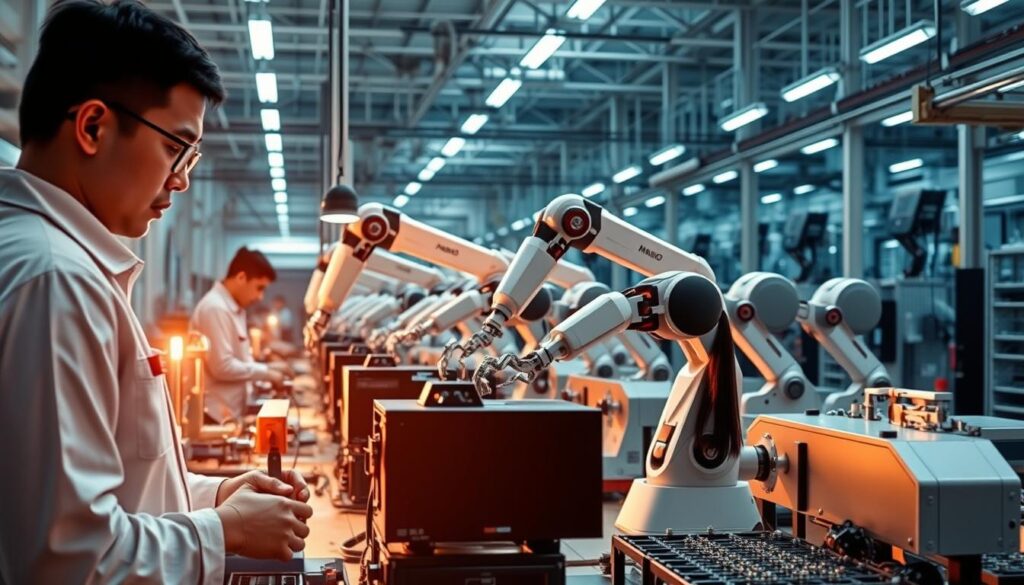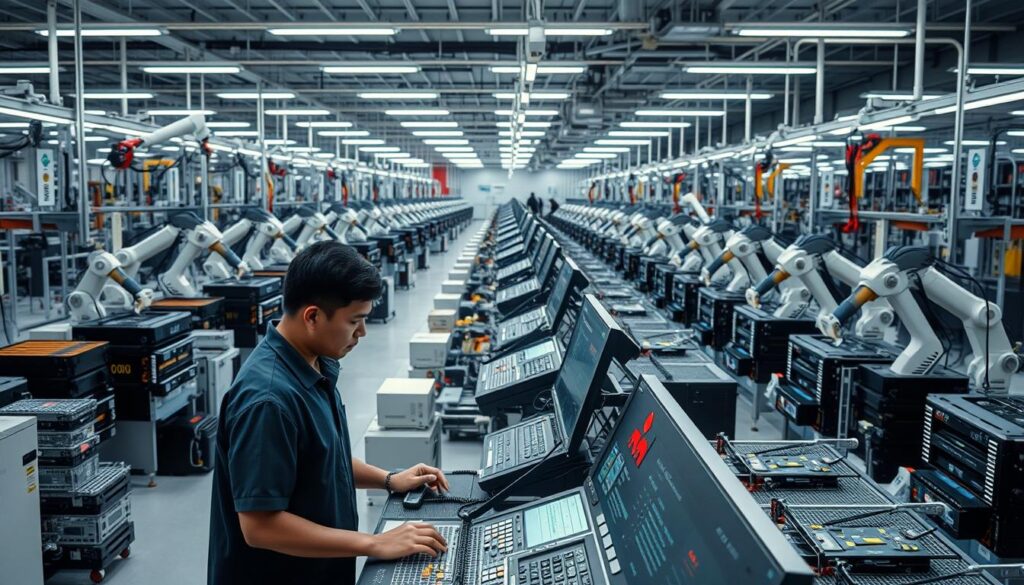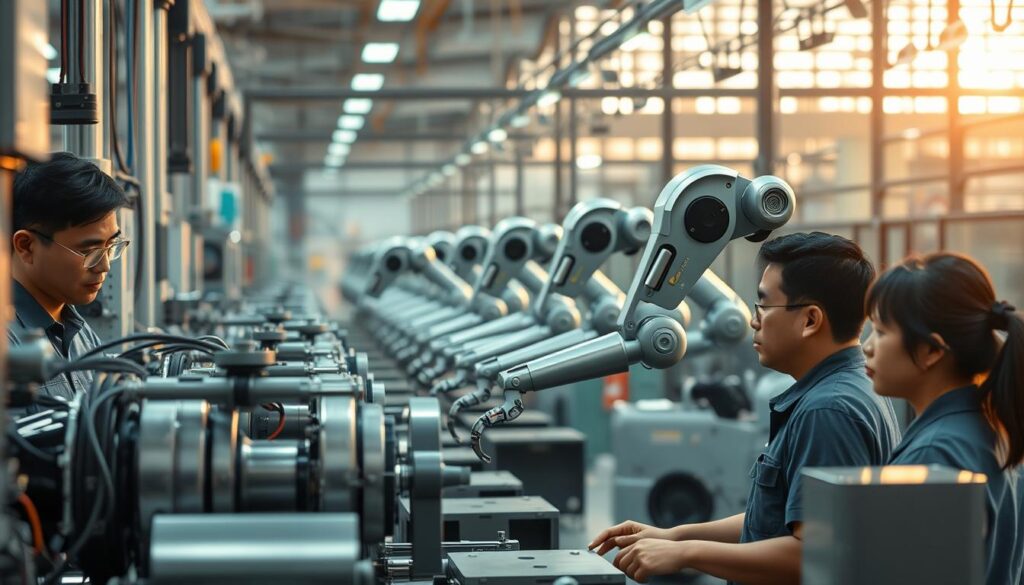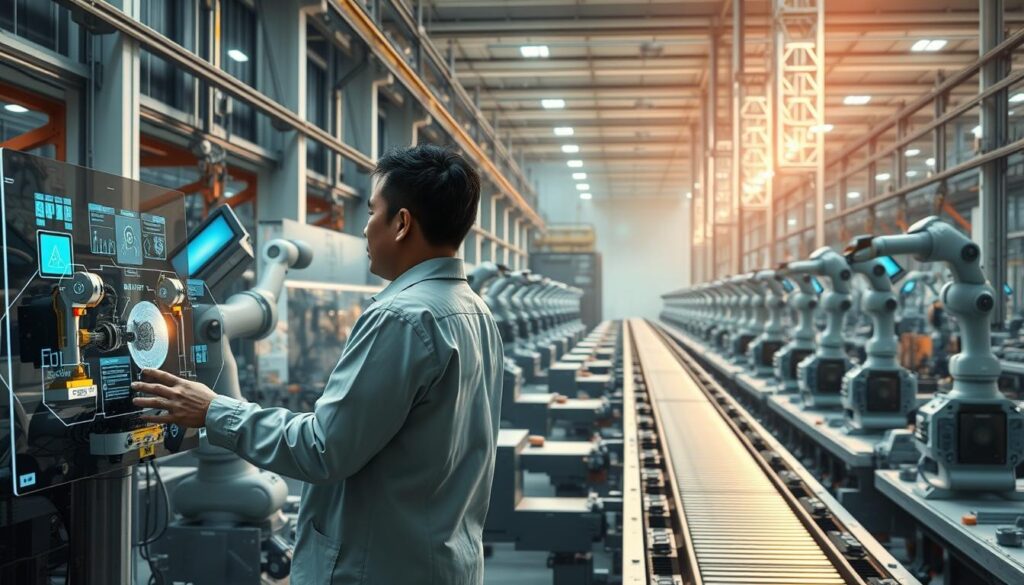How is AI changing the future of making things, and are we ready? The manufacturing world has seen big changes, like the 1950s saw with automation. AI is now leading the way, making things better, more precise, and sustainable. It uses lots of data to make things run smoother, automate tasks, and be more proactive.
This article looks at AI’s big role in making things, covering current trends and new ideas from top Asian companies. We also explore what’s next in Industry 4.0 advancements.
Key Takeaways
- AI makes things more efficient, precise, and adaptable, following Industry 4.0.
- Predictive maintenance cuts down on unexpected stops, saving a lot on maintenance costs.
- AI quality control systems boost product quality by spotting issues accurately.
- AI improves supply chains, helping predict demand and manage stock better.
- Investing in AI is key to staying ahead in making things.
Introduction to AI in Manufacturing
AI in manufacturing uses advanced tech to create systems that can do things humans do. This includes things like understanding complex patterns. Companies all over the world see how important it is to use AI to make production better.
What is AI in Manufacturing?
AI in manufacturing combines tech like machine learning and sensors to make things more efficient. Companies use it to look at big data for insights. About 66% of manufacturers are using more AI, showing it’s becoming key in changing how things are made.
The market for AI in manufacturing is worth around ₱915 billion. This shows how big its impact could be.
Importance of AI for Production
AI in manufacturing is more than just making things faster. It helps companies make decisions quickly with real-time data. For example, AI can predict when machines might break down, saving time.
AI also makes quality control better, catching mistakes before they happen. This means products are more consistent. It also helps companies use resources better and reduce waste.
Current Trends in AI for Industrial Applications
AI technologies are changing the game in industrial applications. They make manufacturing more productive and efficient. Predictive maintenance, quality control, and supply chain optimization are seeing big changes thanks to AI.
Predictive Maintenance
Predictive maintenance uses AI to look at sensor data from machines. This helps businesses know when equipment might fail before it does. It can cut down on unplanned downtime by up to 50%.
Companies using predictive maintenance can save up to 30% on maintenance costs. This boosts the effectiveness of their equipment. It gives them a big advantage over competitors by running their operations at peak levels.
Quality Control Enhancements
AI makes quality control in manufacturing much better. Automated systems with computer vision can spot defects over 90% of the time. This is way better than human inspectors, who are only about 70% accurate.
By analyzing data in real-time, companies can catch defects early. This stops bigger problems from happening later. It’s key to making products better and more reliable.
Supply Chain Optimization
AI is changing how companies manage their supply chains. It helps them understand inventory and predict demand better. AI systems make operations smoother, cutting delivery times by 25-50%.
This not only reduces losses from making too much but also matches supply with demand. For more on AI’s role in supply chains, check out this resource. Adding AI to IoT makes things even better, making operations more open and flexible.

Asian Companies Leading in AI Innovations
Asian companies are leading the way in AI for manufacturing. They’re making big strides in using AI to make factories smarter. This not only makes things run better but also changes the way industries work.
Siemens: Integrating AI in Manufacturing Processes
Siemens is a leader in using AI in factories. They combine AI with IoT to boost factory efficiency. This helps factories work better by using real-time data to make smart choices.
This leads to better productivity, lower costs, and faster changes to meet market demands.
Fanuc: Robotics and AI in Factory Automation
Fanuc is known for its robotics in production. They use AI to make factories work better. Their AI systems help machines and people work together, making things run smoother.
This shows how AI and robotics can change old factory ways. It makes factories more efficient and ready to adapt quickly.
The Benefits of AI in Manufacturing
AI technology brings many benefits to manufacturing. It makes production more efficient and reduces costs. These changes come from automating tasks and using predictive systems for better decision-making.
Enhanced Efficiency and Productivity
Collaborative robots (cobots) help manufacturers work better. AI handles repetitive tasks, freeing up humans for more complex jobs. This teamwork boosts production by 20% and ensures products are made right every time.
Cost Reduction and Resource Management
AI is key in managing resources and cutting costs. Predictive maintenance reduces downtime by 35% to 45%. AI also helps forecast demand, lowering inventory by up to 35% and saving on storage and waste. Companies using AI can make more money while keeping operations smooth.
Improved Quality and Consistency
AI makes quality control better. AI-powered systems spot defects 50% more accurately than humans. Factories using these tools can detect up to 90% of defects and increase productivity by 50%. This leads to happier customers and more consistent products.
| Benefit | AI Impact | Example Statistics |
|---|---|---|
| Enhanced Efficiency | Increases production capacity and throughput | 20% improvement in production efficiency |
| Cost Reduction | Minimizes downtime and optimizes inventory | Reduction in inventory levels by 35% |
| Quality Improvement | Increases accuracy and consistency of products | 90% accuracy in defect detection |
AI Technologies Transforming Production Lines
AI has changed how production lines work. It makes them smarter and more efficient. By using AI, manufacturers can improve quality and productivity.
Machine Learning Algorithms
Machine learning helps analyze data from the shop floor. It finds patterns and predicts when equipment might fail. This way, companies can fix things before they break down.
General Electric (GE) has seen big benefits. They cut downtime by 20% and saved over ₱56 billion. This shows how AI can boost productivity.
Computer Vision Systems
Computer vision systems are a big step forward in quality control. They check products very accurately, catching mistakes humans might miss. These systems work all the time, improving quality by up to 300% and saving over 20% on costs.
Internet of Things (IoT) Integration
AI and IoT work together to make manufacturing smarter. IoT devices send data to AI for analysis. This helps make better decisions and adapt to changes quickly.
For example, IoT data helps predict energy needs. This saves a lot of electricity. AI also helps manage supplies better, saving money on inventory.
| AI Technology | Benefits | Industry Impact |
|---|---|---|
| Machine Learning | Predictive maintenance, reduced downtime | Increased productivity by billions |
| Computer Vision | Real-time defect detection, enhanced quality control | Major cost savings and improved product quality |
| IoT Integration | Real-time data analytics, optimized resource management | Improved decision-making in manufacturing processes |
Case Study: Mitsubishi Electric and AI
Mitsubishi Electric is leading the way in using AI in manufacturing. They use MELSOFT MaiLab to improve production. This tool helps solve big problems in manufacturing by automating tasks and analyzing data.
Overview of Mitsubishi Electric’s AI Applications
MELSOFT MaiLab automates tasks like data collection and predictive modeling. It works on any industrial PC, including Mitsubishi Electric’s MELIPC. This makes it easier to use smart manufacturing solutions for better production insights.
The platform also has a user-friendly interface. It can be customized for different needs and works offline for predictive model development.
Results and Achievements Through AI
Using AI has brought big benefits to Mitsubishi Electric. AI helps reduce downtime and makes production more accurate. For example, AI in welding at a European factory almost always predicts failures.
Over five years, AI has saved nearly EUR 70,000. This shows the real value of AI in manufacturing. Mitsubishi Electric’s algorithms keep getting better, keeping them competitive in the manufacturing world.

Overcoming Challenges in AI Implementation
AI in manufacturing is promising but faces many challenges. Employees worry about losing their jobs and changes in how things are done. Moving to new, automated ways can be scary, showing the need for good change management.
People might not want to use new tech if they don’t feel they can handle it. Talking openly about AI can help ease worries. It shows that AI is meant to help, not replace, people.
Another big problem is fitting AI into old systems. Many places have outdated setups that can’t easily use new AI. Planning well and using the right resources is key to smooth changes without stopping work. Fixing data quality and governance issues is also crucial for AI success.
| Implementation Challenges | Impact on Adoption |
|---|---|
| Resistance to Change | Employees may resist new processes fearing job loss. |
| Poor Data Quality | Inadequate data leads to ineffective AI outcomes. |
| Weak Integration | Difficulty in merging AI with existing systems hampers efficiency. |
| Lack of Trust in AI | Concerns about AI reliability limits its adoption in critical areas. |
Building trust in AI is key, more so in areas where safety matters. Talking about trustworthy AI can help people feel more secure. Working together on AI can help overcome its challenges, making manufacturing better.
Skills Needed for AI in Manufacturing
AI in manufacturing needs specific skills in the workforce. As companies use AI, workers must learn to work with it. This means training to use AI for better productivity.
Importance of Employee Training
Good employee training is key for AI success in manufacturing. Companies should invest in training that teaches both technical skills and innovation. This way, workers can use AI to cut down on maintenance and downtime.
Since 70% of industries use AI, training is more important than ever. For more on training your workforce, check out building AI literacy across your workforce.
Collaboration Between IT and Production Teams
IT and production teams must work together for AI success. This partnership ensures AI meets manufacturing needs. Together, they can make operations more efficient and safer.
As AI grows, this teamwork keeps skills up to date. This helps manufacturing stay competitive.

The Future of AI in Industrial Applications
The world of AI in industry is changing fast. It’s bringing big changes to how we make things and run operations. The market for AI in manufacturing is set to grow from ₱180 billion in 2023 to ₱1.17 trillion by 2028. This shows a big push towards smarter, more efficient systems.
AI makes things run smoother and helps make better decisions.
Predictions for AI Development
More than 70% of makers have started using AI. They see its value in making things, training workers, and helping customers. Generative AI is a big hit, with 83% of leaders planning to use it by 2024.
This tech, along with better AI algorithms, will change how we make products. It will make design faster and use less material. AI could change the job market and make companies more competitive, just like automation did in the 1950s.
Potential New Technologies on the Horizon
AI working with new tech like blockchain and IoT is very promising. Companies like Airbus and General Motors are using generative AI to make parts lighter and stronger. This shows AI’s power to improve performance and save materials.
Investments in AI for making things are set to grow by 57% by 2026. This shows a big push to get better with AI. Companies that use these new techs will lead their fields.
Government Initiatives Supporting AI in Manufacturing
Government efforts are key in boosting AI use in manufacturing. In the Philippines, new policies help make AI adoption easier. The National Artificial Intelligence (AI) Strategy Roadmap 2.0 is set to launch on July 3, 2024. It aims to make big strides in AI use, focusing on ethics and governance.
Policies in the Philippines Encouraging AI Adoption
The new AI strategy aims to use AI to grow the economy and improve life for people. The creation of the Center for AI Research (CAIR) is a big step forward. It will be the Philippines’ first AI hub, attracting innovation and investment.
Other laws, like the Tatak Pinoy Act, support innovation and change in industries. They work with programs like UNIDO’s AIM Global. This aims to advance technology and close the digital gap, following the UN’s 2030 goals.
Regional Collaborations in Southeast Asia
Working together in Southeast Asia boosts AI use by sharing knowledge and resources. The AIM Global Forum brought together AI experts to talk about its impact on manufacturing. These partnerships help bridge technology and expertise gaps.
AI offers big chances in many fields, from making things to healthcare. By focusing on ethical AI and protecting data, countries can grow fairly. These efforts aim to make the manufacturing sector strong and competitive in the region.

AI Ethics and Its Impact on Manufacturing
AI in manufacturing has many benefits but also raises big ethical questions. It affects jobs and data privacy, which are major concerns. Finding a balance between innovation and ethics is crucial for a sustainable future in manufacturing.
Addressing Employment Concerns
AI is making some jobs obsolete, causing worry about job loss. Companies need to train and reskill workers to adapt. It’s important for businesses to update their workforce plans due to AI changes.
Ensuring Data Privacy in AI Systems
Data privacy is key as AI collects lots of personal info. Laws like GDPR and CCPA highlight the need to protect data. Strong privacy measures and ethical AI use are vital for trust in the manufacturing industry.
| Concern | Description | Example |
|---|---|---|
| Job Displacement | The potential loss of jobs due to automation. | Increased use of robots on assembly lines in automotive manufacturing. |
| Data Privacy | Risks associated with the collection and usage of personal data. | Implementation of GDPR provisions in Europe. |
| Ethics in AI | Concerns about algorithmic bias and fairness in AI applications. | Amazon’s scrapped AI project due to gender bias in hiring. |
Conclusion: The Path Forward for AI in Manufacturing
The role of AI in production is becoming more vital. Companies that embrace innovation and adaptability will lead the market. Over the last 20 years, AI has grown from simple predictive maintenance to quality assurance and more.
This change shows a big shift in how industries work. It’s all about being sustainable and efficient. Leaders in AI are key to guiding companies through this change.
They need to inspire and bring teams together. This is crucial for using new technologies well. By training employees and thinking about ethics, leaders help their teams use AI to grow sustainably.
Already, 72% of manufacturers are using AI. This trend is pushing the industry towards a more innovative future. The journey to fully adopt AI will need careful planning and good data.
Manufacturers should focus on specific goals to show the value of AI. This will help them explore more AI-driven possibilities. By doing this, companies can thrive in the changing world of manufacturing.

